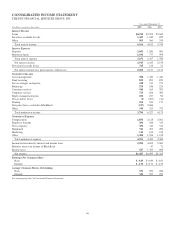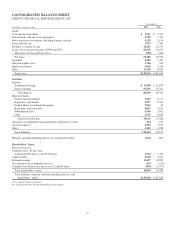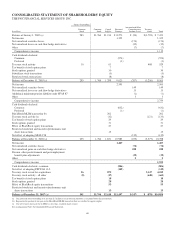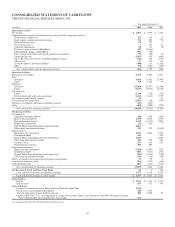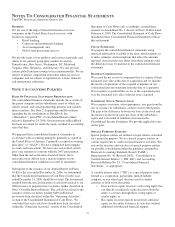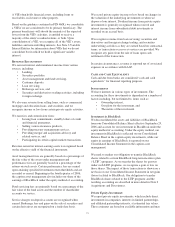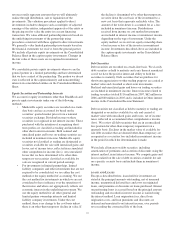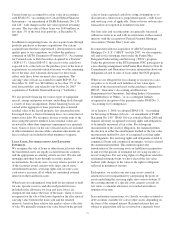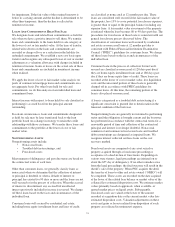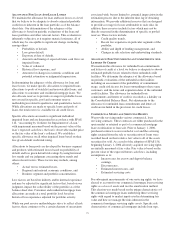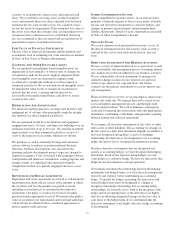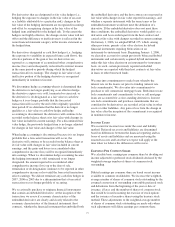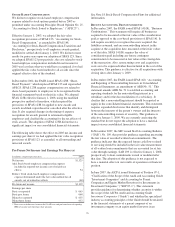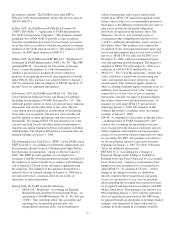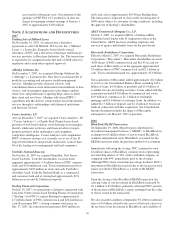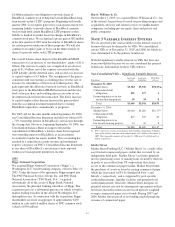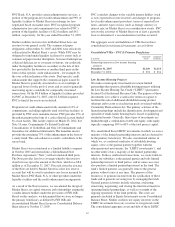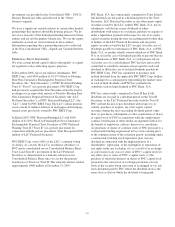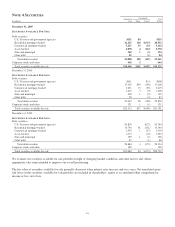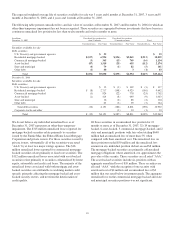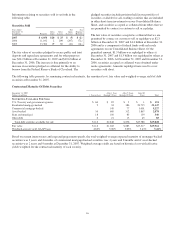PNC Bank 2007 Annual Report Download - page 81
Download and view the complete annual report
Please find page 81 of the 2007 PNC Bank annual report below. You can navigate through the pages in the report by either clicking on the pages listed below, or by using the keyword search tool below to find specific information within the annual report.currency or exchange rate, interest rates and expected cash
flows. We record these servicing assets as other intangible
assets and amortize them over their estimated lives based on
estimated net servicing income or loss. On a quarterly basis,
we test the assets for impairment. If the estimated fair value of
the assets is less than the carrying value, an impairment loss is
recognized and a valuation reserve is established. Servicing
fees are recognized as they are earned and are reported net of
amortization expense in noninterest income.
F
AIR
V
ALUE OF
F
INANCIAL
I
NSTRUMENTS
The fair value of financial instruments and the methods and
assumptions used in estimating fair value amounts are detailed
in Note 16 Fair Value of Financial Instruments.
G
OODWILL
A
ND
O
THER
I
NTANGIBLE
A
SSETS
We test goodwill and indefinite-lived intangible assets for
impairment at least annually, or when events or changes in
circumstances indicate the assets might be impaired. Finite-
lived intangible assets are amortized to expense using
accelerated or straight-line methods over their respective
estimated useful lives. We review finite-lived intangible assets
for impairment when events or changes in circumstances
indicate that the asset’s carrying amount may not be
recoverable from undiscounted future cash flows or it may
exceed its fair value.
D
EPRECIATION
A
ND
A
MORTIZATION
For financial reporting purposes, we depreciate premises and
equipment net of salvage value principally using the straight-
line method over their estimated useful lives.
We use estimated useful lives for furniture and equipment
ranging from one to 10 years, and depreciate buildings over an
estimated useful life of up to 40 years. We amortize leasehold
improvements over their estimated useful lives of up to 15
years or the respective lease terms, whichever is shorter.
We purchase, as well as internally develop and customize,
certain software to enhance or perform internal business
functions. Software development costs incurred in the
planning and post-development project stages are charged to
noninterest expense. Costs associated with designing software
configuration and interfaces, installation, coding programs and
testing systems are capitalized and amortized using the
straight-line method over periods ranging from one to seven
years.
R
EPURCHASE
A
ND
R
ESALE
A
GREEMENTS
Repurchase and resale agreements are treated as collateralized
financing transactions and are carried at the amounts at which
the securities will be subsequently reacquired or resold,
including accrued interest, as specified in the respective
agreements. Our policy is to take possession of securities
purchased under agreements to resell. We monitor the market
value of securities to be repurchased and resold and additional
collateral may be obtained where considered appropriate to
protect against credit exposure.
O
THER
C
OMPREHENSIVE
I
NCOME
Other comprehensive income consists, on an after-tax basis,
primarily of unrealized gains or losses on securities available
for sale and derivatives designated as cash flow hedges, and
changes in pension, postretirement and postemployment
liability adjustments. Details of each component are included
in Note 14 Other Comprehensive Income.
T
REASURY
S
TOCK
We record common stock purchased for treasury at cost. At
the date of subsequent reissue, the treasury stock account is
reduced by the cost of such stock on the first-in, first-out
basis.
D
ERIVATIVE
I
NSTRUMENTS
A
ND
H
EDGING
A
CTIVITIES
We use a variety of financial derivatives as part of our overall
asset and liability risk management process to manage interest
rate, market and credit risk inherent in our business activities.
We use substantially all such instruments to manage risk
related to changes in interest rates. Interest rate and total
return swaps, interest rate caps and floors and futures
contracts are the primary instruments we use for interest rate
risk management.
Financial derivatives involve, to varying degrees, interest rate,
market and credit risk. We manage these risks as part of our
asset and liability management process and through credit
policies and procedures. We seek to minimize counterparty
credit risk by entering into transactions with only high-quality
institutions, establishing credit limits, and generally requiring
bilateral netting and collateral agreements.
We recognize all derivative instruments at fair value as either
other assets or other liabilities. The accounting for changes in
the fair value of a derivative instrument depends on whether it
has been designated and qualifies as part of a hedging
relationship. For derivatives not designated as an accounting
hedge, the gain or loss is recognized in noninterest income.
For those derivative instruments that are designated and
qualify as accounting hedges, we must designate the hedging
instrument, based on the exposure being hedged, as a fair
value hedge or a cash flow hedge. We have no derivatives that
hedge the net investment in a foreign operation.
We formally document the relationship between the hedging
instruments and hedged items, as well as the risk management
objective and strategy, before undertaking an accounting
hedge. To qualify for hedge accounting, the derivatives and
related hedged items must be designated as a hedge at
inception of the hedge relationship. For accounting hedge
relationships, we formally assess, both at the inception of the
hedge and on an ongoing basis, if the derivatives are highly
effective in offsetting designated changes in the fair value or
cash flows of the hedged item. If it is determined that the
derivative instrument is not highly effective, hedge accounting
is discontinued.
76


